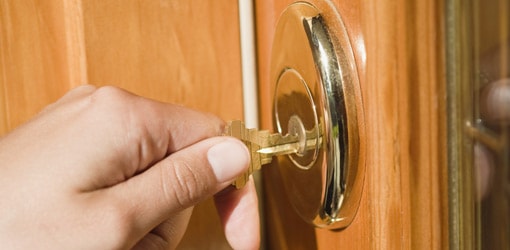Leaving your keys at home isn’t the only way to get locked out. If you—and your key—get stuck, try these three fixes to get inside without having to hire a locksmith.
It’s been one of those days. You caught every red light on your way home from work, your laundry wasn’t ready at the dry cleaners, and now—when you finally get home and are dying to sink into your sofa—you can’t get your key out of the front door’s lock.
While frustrating, it’s usually not that difficult to remove a key that’s stuck, so long as nothing is broken inside the lock. The culprit could be just a loose part of the lock assembly, a sharp burr or ridge on a new key, or a bend in an old one. Forcing a key can cause it to break off in the lock, so take a deep breath and give one of these easy fixes a try.
METHOD 1: PUSH THE PLUG
The keyhole plug in a pin tumbler lock (found in deadbolts and key-in-knob locks) is just one part of a larger locking cylinder. What’s visible to you, the face of the plug, is the small circle surrounding the keyway—and your stuck key. Now, if this plug is loose, it can move slightly within the cylinder and prevent the pin tumblers from aligning, which makes it difficult to unlock the door or remove the key. So, try this:
- Push your key in as far as it will go.
- Turn the key so that the keyway slot is in the exact position it was in when you inserted the key; this is the correct position for the pin tumblers to align in the cylinder.
- With your other hand, use the tip of your finger to push firmly on the face of the plug next to the key.
- Gently twist and pull the key out.
The light pressure applied in Step 3 prevent the plug from shifting as you try to remove the key. In many instances, that’s all it takes.
METHOD 2: LUBRICATE THE LOCK
If stabilizing the cylinder on your house’s lock doesn’t work, it might not be a loose plug causing the problem. New keys and imperfect copies are notorious for hanging on tumbler pins.
Spray lubricant like WD-40 makes a great assistant when attempting to retrieve a key stuck in a lock, and most cans come with a tiny straw nozzle for getting into spaces as tight as a keyhole. (If you don’t keep some handy in your car’s trunk, a quick run to the store might be in order.)
- Hold the application straw right above your stuck key, aiming it into the hole.
- Now, wiggle the key (up and down, not side to side) to work it out of the lock.
Once it’s out, use a fine file to smooth away any barbs or sharp points on the key teeth to prevent future sticking, or ask the key maker to file them down for you
METHOD 3: TURN UP THE HEAT
Excessive twisting and prying at a stuck key could take a situation from bad to worse: You might end up breaking the key in half inside the lock. Should this happen, you do have a couple of DIY options still available to you before calling in professional assistance.
- First, simply slick the keyway with a squirt of spray graphite or lubricant, then attempt to grab any visible end of the key using a pair of needle-nose pliers.
- If you don’t have enough metal extending from the keyway to grip, run to the store to pick up an under-$10 tool made just for the job—a broken key extractor kit.
- Select the size of specialty tool from the kit best fit for your problem lock, and slide the slim implement along the recessed groove of the key as far as it will go.
- Once in place, turn it so that its hook can grab the key’s tip, then pull it back toward you to try dislodging the remaining chunk of key.
If at first you don’t succeed, try, try again!
Of course, if you’re still stuck after trying all of these fixes, rest assured you have given it your best shot—this job is truly one for the professionals. You’ll need to call a locksmith to either retrieve the key or replace the lock altogether. Then, going forward, save yourself the sticky situation! Aim to keep a spare handy to switch into your key ring if your primary one begins to bend with wear—a warped key is more likely to stick down the road than a straight key. Also, give your locks a quick squirt of lubricant every few months to dissolve any gunk and keep the locking mechanisms moving freely. With this minimal effort, you may never have to wrestle with a stuck key again.




